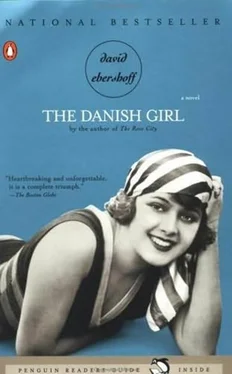
For their August holiday, Greta and Einar returned, as they did every summer, to Menton, a French harbor town on the border of Italy. After the long summer, Greta said goodbye to Copenhagen with a sense of relief. As their train rattled south and over the Maritime Alps, she felt as if she was leaving something behind.
This year, on a tip from Anna, who in May had sung at the opera in Monte Carlo, Greta and Einar rented an apartment on the avenue Boyer, across the street from Menton’s municipal casino. The apartment’s owner was an American who had hurried to France after the war to buy up the shuttered garment factories of Provence. He became rich and now lived in New York, his mail full of profits from the simple, unlined housedresses he sold to every housewife south of Lyon.
The apartment had a cold orange marble floor and a second bedroom painted red and, in the living room, a Chinese screen inlaid with abalone shell. The front windows opened onto little terraces wide enough for a row of geranium pots and two wire chairs. There Einar and Greta would sit in the hot nights, Greta’s feet on the rail, a rare breeze blowing up from the lemon and orange trees in the park below. Greta was tired, and she and Einar could pass an evening saying no more than “Good night.”
On the fifth day of their holiday, the weather turned. Sirocco winds from North Africa hurtled across the dimpled Mediterranean, up the rocky beach, and through the open terrace doors, knocking over the Chinese screen.
Greta and Einar were napping in the red bedroom when they heard the crash. They found the screen flat against the camelback sofa. The screen had been hiding a rack of sample housedresses manufactured by the apartment’s owner in his factories. The dresses, white with floral prints, were fluttering on the rack, as if a child were tugging on their hems.
They were rather plain, Greta thought, with their ugly cuffed sleeves and button fronts convenient for breast feeding-so plain and practical she began to feel a remote sense of dislike for the women who wore them. She moved to set right the Chinese screen. “Give me a hand?” she said.
Einar was standing next to the sample rack, the dress hems blowing against his leg. His face was still. Greta could see the veins in his temples pulsing. She could see his fingers, which she always thought of as the fingers of a pianist, not a painter, trembling. “I was thinking of asking Lili to visit us,” he said. “She’s never been to France.”
Greta had never turned Lili away. There were times, over the course of the summer, when Einar would announce that Lili would be coming to dinner and Greta, drained from a day attending her failed exhibition, would think, Oh, jeepers, the last thing I want to do right now is dine with my husband dressed up as a girl. But Greta would keep such a thought to herself, biting her lip until she could taste her own blood. She knew she couldn’t stop Einar. She knew, from what had happened with Henrik, that Lili had a will of her own.
In the weeks before they left for Menton, Lili had begun to appear unannounced in the afternoons. Greta would leave the Widow House for an appointment. When she returned she’d find Lili at the window in a loose dress, the back buttons unfastened. Greta would help her finish dressing, clasping a string of amber beads around her throat. It never ceased to startle Greta, finding her husband like that, waiting with the neckline of a dress open across his pale shoulders. She never once said anything to Einar, or to Lili. Instead, she would always welcome Lili as if she were an amusing, foreign friend. She ’d hum and gossip as she helped Lili into her shoes. Greta would tip a bottle of perfume against her forefinger and then run her sweet fingertip down Lili’s throat and up the inside of her arm. She would stand Lili in front of the mirror and whisper, her voice the soft intimate voice of wedlock, “There now… so very pretty.”
All of this Greta did with a sense of devotion, for she always believed she could defy anyone in the world except her husband. It had been the same with Teddy. She could cross her mother and debate her father and snub all of Pasadena and Copenhagen alike, but in her chest was a bottomless well of tolerance for the man she loved. She never questioned it, why she allowed Lili to come into their lives. Anything to make Einar happy, she would tell herself. Anything at all.
And yet, Greta being Greta, this open devotion sometimes chafed against her. After Lili’s assignations with Henrik, Greta began to escort her on her trips into the Copenhagen streets. Lili had told her that she would never see Henrik again, that they’d had a falling-out, but even so, Greta knew there were dozens of other young men who could flatter Lili until she blushed and fell into their arms. And so Greta and Lili would stroll with their arms linked at the elbow through the boxhedges of the park. Greta’s eyes would patrol the gravel paths for potential suitors, knowing what Lili, with her moist brown eyes, could stir in young Danish men. One day Greta took a photograph of Lili at the gate of Rosenborg Slot, the slim brick castle behind Lili blurry and vaguely menacing. Another day Lili stopped Greta at the marionette theatre and sat with the children, her face as tentative, her legs as coltish, as theirs.
“Greta?” Einar said again. He was leaning against the rack of sample dresses. The Chinese screen was still lying against the sofa. “You won’t mind if Lili visits us here?”
Greta began to stand the screen upright. Since they arrived in France she hadn’t painted. She hadn’t met anyone interesting enough to ask to sit for a portrait. The weather had been heavy and humid, making it difficult for paint to dry on the canvas. Over the summer she had begun to change her style, using brighter colors, especially pinks and yellows and golds, and flatter lines and an even larger scale. It was a new way of painting for Greta, and it took her a longer time to start again at a blank canvas. She hardly felt confident about the paintings. With their oversized and pastel tone of joy, her recent paintings required, on Greta’s part, an inner sense of rapture. Nothing made her happier than painting Lili.
Greta thought about starting a full-scale portrait of her on the terrace, a breeze lifting her hair and the hem of her housedress, the little brown roses on the dress a pretty blur, the expression on Lili’s face just like the one on her husband’s at this very moment-hot, anxious, his skin tight and red and about to burst.
Greta and Lili were walking to L’Orchidée on quai Bonaparte. The restaurant was known for its ink-boiled squid, or so Hans had written, proposing an evening to meet. On the street the shops were closed for the night. Little sacks of yesterday’s refuse were resting on the curb. The cobblestones were loose in the road, rutted from the pneumatics of motorcars.
Hans’s letter was in Greta’s pocket, and she was rubbing its corner against her wedding ring as she and Lili walked along rue St.-Michel toward the harbor. To Greta, one of the nicer Danish customs was that the wedding band was worn on the right hand. When she’d returned to Denmark a widow, she’d sworn to herself she would never remove the brushed gold band Teddy had given her. But then Einar offered her his own band, a simple loop of gold. She didn’t know how she could remove Teddy’s ring; she thought of him giving it to her, he clumsily searching his pockets for the little black velvet box. But then Greta realized she wouldn’t have to take off Teddy’s, and now she wore both. She played with the rings equally, turning them on her fingers absentmindedly.
Читать дальше













